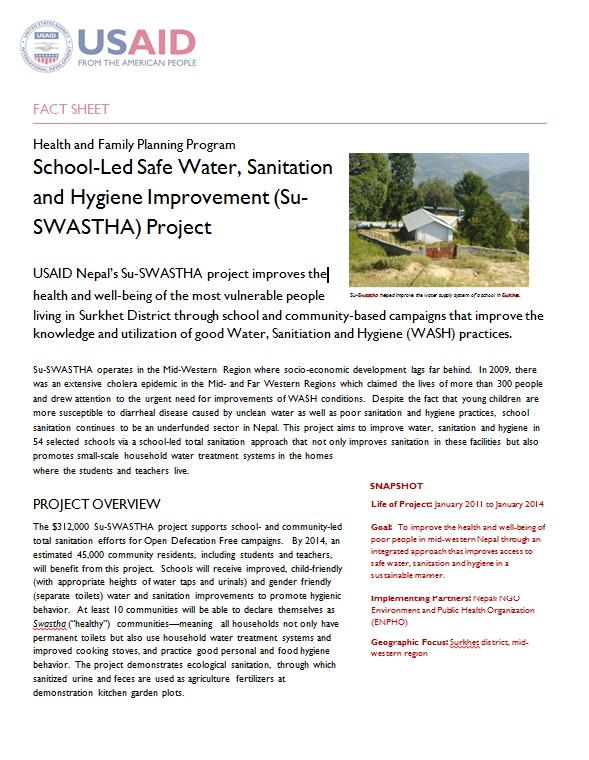Su-SWASTHA operates in the Mid-Western Region where socio-economic development lags far behind. In 2009, there was an extensive cholera epidemic in the Mid- and Far Western Regions which claimed the lives of more than 300 people and drew attention to the urgent need for improvements of WASH conditions. Despite the fact that young children are more susceptible to diarrheal disease caused by unclean water as well as poor sanitation and hygiene practices, school sanitation continues to be an underfunded sector in Nepal. This project aims to improve water, sanitation and hygiene in 54 selected schools via a school-led total sanitation approach that not only improves sanitation in these facilities but also promotes small-scale household water treatment systems in the homes where the students and teachers live.
PROJECT OVERVIEW
The $312,000 Su-SWASTHA project supports school- and community-led total sanitation efforts for Open Defecation Free campaigns. By 2014, an estimated 45,000 community residents, including students and teachers, will benefit from this project. Schools will receive improved, child-friendly (with appropriate heights of water taps and urinals) and gender friendly (separate toilets) water and sanitation improvements to promote hygienic behavior. At least 10 communities will be able to declare themselves as Swastha (“healthy”) communities—meaning all households not only have permanent toilets but also use household water treatment systems and improved cooking stoves, and practice good personal and food hygiene behavior. The project demonstrates ecological sanitation, through which sanitized urine and feces are used as agriculture fertilizers at demonstration kitchen garden plots.
This project operates in five village development committees (VDCs) of Surkhet District and in three wards of Surkhet Municipality, in close coordination with the Mid-Western Regional Office of Drinking Water Supply and Sanitation. By aligning with the Nepal Master Plan for Hygiene and Sanitation, Su-SWASTHA coordinates closely with district and village level WASH coordination committees.
PROJECT OBJECTIVES
The project will provide three major results:
- Improve access to safe drinking water and sanitation through a school-led total sanitation strategy, and construction, renovation and protection of water supply systems for schools.
- Improve hygiene behavior through the capacity building of local partners and community groups to deliver messages and improve knowledge and hygiene behaviors in the working communities.
- Enhance local governance of the WASH sector by strengthening the capacity of local partners and fostering effective coordination among the concerned stakeholders.
Su-SWASTHA shares its learning with other WASH stakeholders to foster the expansion of the national sanitation movement and to achieve the national goal of total sanitation in Nepal by 2017. The achievement of this goal will improve public health and contribute to a heightened sense of dignity and cohesion in communities across Nepal.
KEY OUTCOMES
- Five VDCs and three municipal wards declared Open Defecation Free.
- 54 schools with improved, child and gender-friendly WASH facilities.
- Ten communities declared as SWASTHA communities (all households have toilets, using household water treatment systems and practicing selected personal and food hygiene behaviors).
- Five Water Safety Plans implemented to improve water supply schemes from the source to the point of use in order to reduce water quality related health risks.








Comment
Make a general inquiry or suggest an improvement.